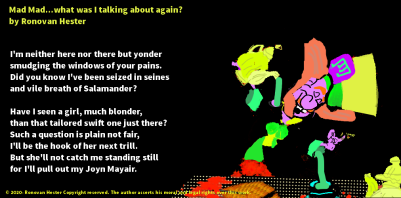How to write an Espinela/Décima poem.

The Traditional Décima Poem
Décima poetry is a 10 line stanza with 8 syllables per line. The rhyming pattern is abbaaccddc. Using the 10 lines there are generally two ways to organize: The 10 lines, or breaking the 10 lines into two stanzas using abba/accddc.
The abba/accddc requires either a period or semicolon after the fourth line break.
Also, there can only be pauses after even verses, particularly after the fourth. Edit-09/04/2020
Topics are as varied as your imagination. With the Décima the subject matter tends to be more socially conscience than some poems. Philosophical, political, dogma, and religious ideas are among the topics. Although, it can also be in the form of satire, criticism, and insulting to an enemy/opponent in a situation.
Just imagine if the candidates for a public office decided to write Décima challenges. First, one candidate would write a 10 line stanza and have a decimista/decimero read it aloud at the opponents next TV appearance. The opponent then responds with another 10 line stanza and a decimista/decimero would return the favor. This would go on for ever how long it will, and sometimes ends up as a song of challenge.
Back in the day, the poems were written anonymously, thus the reason for a decimero. I imagine it was always known who the writer was, at least in matters of romance…maybe.
The reason this form of poetry is also called Espinela is because of Vicente Espinel who was a Spanish writer, musician, soldier, prisoner of pirates, and finally a priest. He is sometimes noted as the founder of the décima or the one to popularize it once again.
Tools I use in my Haiku Challenges each week will definitely be even more useful here. There are the following three RhymeZone.com, Thesaurus.com, and finally HowManySyllables.com. Look for the new Espinela Poetry Challenge beginning 4/17/2020.
An example of an abba/accddc décima:
On soft breeze a divine bouquet
her invitation is discrete,
to imbibe in her gifts so sweet,
and my heart with joy must obey.
Eternal beasts come into play.
Distance is an icy lover,
these shivers I cannot cover.
Time will tell the battles end.
I’ll travel along that soft wind,
to love to rediscover.
If you like, there is a Décima Challenge here each Wednesday.
Here is the quick and perhaps easier description of a Décima Poem:
I’ve had a much-valued part of my poetry family let me know that my description might not be clear enough, so I’ve come up with this. There are 10 lines (stanza) of poetry, but unlike other poetry that rhymes there is a strict set rhyming pattern, we must stick to.
In addition, each line must only have 8 syllables.
The rhyme pattern is;
a
b
b
a
a
c
c
d
d
c
But remember, if you want to be a slight bit different, you can do the four lines of abba, then the six lines of accddc.
Décima as Song
Songs have been created for years using Décima poetry. Using the abba/accddc two stanza method and repeat until you have your song. There will be a more complete post about this another time, just know Décima plays a large part in the Latin American culture.
In Ecuador, they do a forty-four line Décima with a four-line opening, no set pattern of rhyme and each of the four lines from the opening stanza goes on to appear later in the song, although perhaps a bit modified.
“The [Décima] is one of the most deeply-rooted and widely distributed strophic forms throughout Latin America, being especially significant in popular and rural poetry. An example of this is the current survival of practices such as payas, where it is often used that two or more singers face each other in a duel of improvised [Décima] at the time, with musical accompaniment, generally the guitar.” from Wikipedia and translated using google translate. Payas: to improvise a song.
© 2020 Ronovan Hester Copyright reserved. The author asserts his moral and legal rights over this work.
Spread this stuff everywhere!






